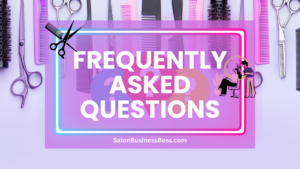Starting a salon business can be an exciting venture, filled with opportunities to express your creativity and passion for making people look and feel their best. However, before you dive into the world of hair, nails, and beauty, it’s crucial to develop a solid business plan. One of the most critical components of any business plan is the market analysis.
To succeed in the salon industry, a thorough market analysis is essential for your business plan. It unveils your target market, competition, and growth potential—keys to crafting a winning strategy.
In this article, we’ll explore the key steps and considerations in conducting a comprehensive market analysis for your salon business plan.
Understanding the Purpose of a Market Analysis

Before diving into the intricacies of market analysis, it’s essential to grasp its significance. Market analysis is essentially an in-depth exploration of your target market and industry. Its primary purpose is to provide you with a clear understanding of your current market conditions, potential customers, competitors, as well as the opportunities and challenges that may lie ahead. Armed with this knowledge, you can make well-informed decisions and develop a business strategy tailored to your specific market.
In simpler terms, think of market analysis as your compass in the business world. It helps you identify who your customers are, what your competition looks like, and what hurdles and prospects you might encounter on your journey. With this information at your disposal, you can navigate the business landscape more effectively, making choices that align with the unique characteristics of your market.
Read more about: From Dream to Reality: Hair Salon Startup Costs
Identifying Your Target Market
The first step in conducting a market analysis is identifying your target market. This involves defining the demographics, psychographics, and behaviors of your ideal customers. Consider questions like:
- Who are your potential customers? Are they primarily men, women, or a mix of both?
- What is the age range of your target audience?
- What income bracket do they fall into?
- What are their interests and preferences when it comes to beauty and grooming services?
- Where do they live and work?
By responding to these inquiries, you can construct a comprehensive picture of your intended market. As an illustration, your target market could consist of women between the ages of 25 and 45, generally falling within the middle to upper income bracket, who place a high importance on using natural and environmentally-friendly beauty products. This profile becomes a valuable tool for steering your marketing initiatives and adapting your salon’s offerings to fulfill their requirements.
In more straightforward terms, when you answer these questions, you’re essentially painting a detailed portrait of the people you want to serve in your salon. In this case, picture a group of women, mostly aged 25 to 45, who have a bit more income to spend, and who prefer using beauty products that are kind to the environment. This portrait becomes your guide for how you promote your salon and shape the services you offer to align with their preferences.
Analyzing Market Trends
Once you’ve defined your target market, it’s time to analyze market trends. This involves researching the beauty and salon industry as a whole. Look for trends in:
- Consumer preferences: What beauty treatments and services are currently popular?
- Industry innovations: Are there new technologies or products that are gaining traction in the beauty industry?
- Competitive landscape: Who are your direct and indirect competitors in the area? What services do they offer, and how do they market themselves?
- Economic factors: How is the economy affecting consumer spending on beauty services?
- Regulatory changes: Are there any new regulations or licensing requirements that could impact your salon?
Getting a grip on these trends serves a vital purpose: it allows you to be ready for changes in the market and set up your salon to change and do well.
In simpler terms, think of it like this: Imagine you’re on a ship in the ocean. To keep your ship safe and moving in the right direction, you need to know about the tides and waves. Similarly, in the business world, understanding market trends is like having a map of where the currents are going. It helps you avoid rough waters and find the best route for your salon to sail smoothly.
If you know, for instance, that more people are interested in eco-friendly beauty products, you can stock your salon with those. If a new hairstyle or treatment is becoming popular, you can offer it to attract more customers. By staying aware of these trends, you stay ahead of the game and ensure your salon stays afloat and prospers.
Conducting Competitive Analysis

A crucial aspect of your market analysis is evaluating your competitors. You’ll want to identify both direct competitors (other salons offering similar services) and indirect competitors (alternative ways people might satisfy their beauty needs). Here are some steps to consider:
- Create a list of your direct competitors in your local area. Visit their websites, read customer reviews, and analyze their pricing, services, and branding.
- Look for gaps in the market. Are there services or customer needs that are not being adequately addressed by your competitors?
- Consider your indirect competitors. These could include at-home beauty products, mobile stylists, or even DIY tutorials. Understanding these alternatives will help you position your salon effectively.
A competitive analysis has another important role—it helps you find ways to stand out. Here’s an example: Imagine you’re looking at all the other salons around you, and you realize that none of them are offering eco-friendly products and services. This means there’s a gap in the market, an opportunity waiting to be taken.
So, what you can do is focus on being the salon that specializes in eco-friendly beauty. By doing this, you set yourself apart from the competition. Customers who care about the environment will be drawn to your salon because you offer something unique that others don’t. This is what we call differentiation, making yourself different in a way that appeals to customers.
In simpler terms, it’s like being the only store in town that sells a certain type of candy. People who love that candy will come to your store because they can’t get it anywhere else nearby. Similarly, by offering eco-friendly services when no one else does, you attract customers who care about the environment. This can be a smart way to grow your business.
Read more about: From Idea to Operation: Your Tanning Salon Business Startup
Defining Your Unique Selling Proposition (USP)
Your salon’s unique selling proposition (USP) is what sets you apart from the competition. It’s your secret sauce, the reason why customers should choose your salon over others. Your USP could be based on factors like:
- Exceptional customer service
- Specialized services (e.g., extensions, color correction, or bridal packages)
- A commitment to using natural and organic products
- Convenient location and hours of operation
- Affordable pricing
- Creative and talented stylists
Your Unique Selling Proposition (USP) is like your salon’s special recipe for growth. To make it work, your USP needs to match what your customers want and need. It’s like cooking a meal that your guests will love—you use ingredients that you know they enjoy.
Think of your USP as the promise you make to your customers. It’s what sets you apart from other salons and makes people remember you. For instance, if your target customers really care about eco-friendly products, your USP could be offering exclusively organic and environmentally friendly services. This promise tells your customers that when they come to your salon, they’ll get what they value most.
In simpler words, it’s like being the one bakery in town that makes amazing gluten-free cakes if you know many people in your area have gluten allergies. Your promise is that when people order a cake from you, it’ll be delicious and safe for them to eat. Your USP works the same way—it’s your special offer that customers can count on and remember you for.
Analyzing Market Size and Growth Potential
Knowing the size and potential growth of your market is really important for the long run. It’s like knowing how big your playground is and if it’s going to get bigger. To figure this out, start by looking at the people who live in the area you want to serve. How many of them could become your customers, based on their age, income, and interests?
After that, take a look at how the beauty and salon industry is doing. Is it getting bigger, like a balloon filling with air, or is it staying about the same size? To understand this, you can check what experts say about the future. If they predict more people will want salon services in your area, it could be a good idea to open your salon there.
In simple terms, it’s a bit like deciding where to open a lemonade stand. You want to put it where there are lots of thirsty people, and it’s even better if more people are moving to your neighborhood. That way, you have a better chance of selling a lot of lemonade. The same goes for your salon – you want to be where there are enough potential customers, and the industry is growing, so your business can thrive.
Estimating Market Demand

Market demand is a key factor in determining the sustainability of your salon business. To estimate demand, consider factors like:
- Population density in your target area
- The frequency at which your target customers typically use salon services (e.g., monthly haircuts or bi-weekly manicures)
- Seasonal fluctuations in demand (e.g., increased business during wedding seasons)
- Special occasions or events that might drive increased demand (e.g., proms, holidays)
Estimating market demand is like figuring out how much cake you should bake for a party. You want to make sure you have enough cake for everyone without baking too much and wasting it. Similarly, in your salon business, estimating market demand means understanding how many customers you can expect.
With this understanding, you can make smart choices about your salon’s size, how many people you need to hire, and what products you should have in stock. If you know there will be a lot of customers, you’ll need a bigger salon and more staff. On the other hand, if the demand is lower, you can keep things smaller and more manageable.
It’s a bit like deciding how many slices of cake to cut. If you know there will be many guests, you cut more slices. But if it’s a small gathering, you cut fewer slices. Estimating market demand helps you slice your business plans just right, so you can serve your customers effectively without wasting resources.
Read more about: Hair Salon Marketing Ideas: Navigating Trends with Flair
Pricing Strategy
Your pricing strategy is a big deal when it comes to getting and keeping customers. Think of it like setting the right price for a product you want to sell. In this case, your product is the salon services you offer.
To set the right price, first, look at what other salons around you are charging. This is like checking what other sellers are asking for a similar item. It gives you an idea of what people are willing to pay.
Now, you need to decide where your salon fits in. Do you want to be a high-end salon with higher prices, offering exclusive services? Or do you want to keep prices lower to attract a broader range of customers?
But here’s the important part: your price needs to cover all your costs. Think about how much it costs to run your salon—things like rent, electricity, employee salaries, and the products you use. Your price should not only cover these costs but also leave you with some extra money, which is your profit.
In simple terms, it’s like making sure you sell your lemonade for more than it costs to make it. That way, you can pay for everything and still have some money left in your pocket. The same goes for your salon – set a price that covers all your expenses and helps you make a profit.
SWOT Analysis
A SWOT analysis is a valuable tool in your market analysis toolkit. It helps you assess your salon’s strengths, weaknesses, opportunities, and threats. Here’s how it works:
- Strengths: Identify what your salon does exceptionally well. This could be your skilled stylists, unique services, or prime location.
- Weaknesses: Acknowledge areas where your salon may be lacking, such as limited brand recognition, a small marketing budget, or a lack of experience in the industry.
- Opportunities: Explore potential growth opportunities in the market. These could be trends, gaps in the market, or partnerships that could benefit your salon.
- Threats: Recognize external factors that could pose a threat to your salon’s triumph. This might include economic downturns, increased competition, or changing consumer preferences.
By doing a SWOT analysis, you see the good and not-so-good parts of your salon clearly. This helps you come up with strategies to use your strengths, improve your weaknesses, seize opportunities, and protect against threats. It’s like having a map that shows you where the sunny spots are and where the rough patches might be in your salon journey.
Gathering Data and Conducting Surveys

To make your market analysis strong, you need facts and opinions from different places. Imagine you’re making a big decision, like choosing what to cook for a party. You’d want to know what people like to eat, right? Market analysis is a bit like that.
You can collect this information from a few places. First, you can look at reports about the beauty industry and official data from the government. These are like cookbooks with recipes you can use to make your dish better.
But to get the real flavor, you need to ask people directly. Surveys are like talking to your guests and asking what they want to eat. You can do this in different ways: online, by sending questions on the internet, or in-person, by talking face-to-face.
You’d ask things like, “What do you usually do to look beautiful?” or “Why do you choose a particular salon?” This gives you a taste of what people like and helps you make your salon and advertising more appealing.
So, just like a good chef tastes their food before serving it, you gather information to make sure your salon is what people want and like.
Read more about: Hair Salon Marketing Tips: Mastering Client Engagement
Market Entry Strategy
As you analyze the market, it’s essential to develop a clear market entry strategy. This strategy outlines how you plan to enter the market and position your salon for triumph. Consider factors like:
- Location: Choose a location that aligns with your target market and is easily accessible.
- Marketing: Develop a marketing plan that highlights your USP and reaches your target audience.
- Pricing: Set competitive pricing for your services.
- Partnerships: Explore potential partnerships with complementary businesses, such as beauty product suppliers or wedding planners.
Your market entry strategy is like having a plan for the first part of your adventure. It guides your decisions and keeps you on track as you set up your salon in the market. Just like a good map, it helps you reach your destination effectively.
Conclusion
A comprehensive market analysis is the foundation of a salon business plan. It provides you with the knowledge and insights needed to make informed decisions, set strategic goals, and position your salon effectively in a competitive market. By understanding your target market, analyzing industry trends, and conducting a thorough competitive analysis, you can create a salon that not only meets the needs of your customers but also stands out in the beauty industry. So, get ready to make your salon dreams a reality and help your customers look and feel their best.
Frequently Asked Questions

Q: What is the purpose of a market analysis in a business plan?
A: A market analysis in a business plan serves to provide a comprehensive understanding of the industry, target market, and competition. It helps businesses make informed decisions and tailor strategies to their specific market.
Q: How can I identify my target market for a new business venture?
A: Identifying your target market involves researching demographics, psychographics, and consumer behaviors. Analyzing factors such as age, income, location, interests, and preferences helps create a clear profile of potential customers.
Q: Why is competitive analysis important when developing a business plan?
A: Competitive analysis is crucial as it helps businesses understand their rivals, their strengths and weaknesses, and market trends. This knowledge aids in positioning the business effectively, differentiating from competitors, and seizing opportunities.
To learn more on how to start you own salon checkout my startup documents here.
The information provided by SalonBusinessBoss.com (“The Site”) is for general informational purposes only. All information on the Site is provided in good faith, however, we make no representation or warranty of any kind, express or implied, regarding the accuracy, adequacy, validity, reliability, availability or completeness of any information on the Site. Under no circumstance shall we have any liability to you for any loss or damage of any kind incurred as a result of the use of the Site or Reliance on any information provided on the Site. Your use of the Site and your reliance on any information on the Site is solely at your own risk. This blog post is for educational purposes only and does not constitute legal advice. Please consult a legal expert to address your specific needs. Terms and Conditions. (https://salonbusinessboss.com/terms-conditions/)

About the author. Entrepreneur and Salon Business Fan.
Hi! I am Shawn and I am a happy individual who happens to be an entrepreneur. I have owned several types of businesses in my life from a coffee shop to an import and export business to an online review business plus a few more and now I create online salon business resources for those interested in starting new ventures. It’s demanding work but I love it. I do it for those passionate about their business and their goals. That’s why when I meet a salon business owner, I see myself. I know how hard the struggle is to retain clients, find good employees and keep the business growing all while trying to stay competitive.
That’s why I created Salon Business Boss: I want to help salon business owners like you build a thriving business that brings you endless joy and supports your ideal lifestyle.

